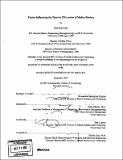| dc.contributor.advisor | Fiona Murray and Stan Lapidus. | en_US |
| dc.contributor.author | Singh, Inder Raj, S.M. Massachusetts Institute of Technology | en_US |
| dc.contributor.other | Harvard University--MIT Division of Health Sciences and Technology. | en_US |
| dc.date.accessioned | 2008-09-03T14:55:04Z | |
| dc.date.available | 2008-09-03T14:55:04Z | |
| dc.date.copyright | 2007 | en_US |
| dc.date.issued | 2007 | en_US |
| dc.identifier.uri | http://hdl.handle.net/1721.1/42216 | |
| dc.description | Thesis (S.M.)--Harvard-MIT Division of Health Sciences and Technology, 2007. | en_US |
| dc.description | Includes bibliographical references (leaf 98). | en_US |
| dc.description.abstract | Companies must receive marketing authorization by the Food and Drug Administration (FDA) before they can begin commercial distribution of a new type of medical device in the United States. The premarket approval application (PMA) is the process by which this occurs. Companies submit a PMA after they have completed laboratory test, animal studies and human clinical trials to demonstrate the safety and effectiveness of the device for a specific condition, or therapeutic indication. Despite legislation in the early part of this decade to reduce the timeframe for FDA review of PMAs, these timeframes continue to vary dramatically and unpredictably from months to many years. The focus of this thesis is to examine factors which influence this timeframe. Hypotheses about factors that impact PMA review timeframes were developed by analyzing the review process and through interviews with industry representatives and FDA officials. The following factors were evaluated: year of submission to FDA, size of firm seeking approval, presence of prior approved PMAs by firm seeking approval, product category, first-of-a-kind device, number of amendments, expedited review status, advisory panel review, unanimous advisory panel vote, and confirmation of primary efficacy endpoints in pivotal clinical trials. The year of submission was considered a control variable. The other factors fall into one of three categories: applicant characteristics, device characteristics, and process characteristics. Analysis was limited to PMAs received by FDA from 2000 through 2005. Two levels of analysis were conducted. | en_US |
| dc.description.abstract | (cont.) First, the directional impact of each factor on PMA review time was evaluated. Second, regression analysis was used to develop predictive models for PMA review time, in days, and to test which factors have meaningful associations when controlling for other factors. Factors that have highly statistically significant associations with longer review timeframes include: a larger number of amendments, and designation as an orthopedic device. Designation as an orthopedic device has a particularly dramatic impact on PMA review time. Orthopedic devices have a mean PMA review time of 647 days, 240 days longer (66% more) than the average for all other categories combined. Even after controlling for process, device, and applicant factors, the impact of an orthopedic designation remains large, increasing the review time by 175 days (p<0.01). In a univariate regression model, each additional amendment is associated with 20.2 additional days (p<0.0001) of review time. After controlling for other factors, each additional amendment is associated with 17.5 additional days (p<0.0001) of review time. Although the number of amendments cannot be known - or predicted - in advance of PMA submission, its significance (R-squared of 0.25 in a univariate regression model) in predicting PMA review timeframes reinforces the notion that quality - primarily of the dossier, in terms of its organization, clarity and completeness, but also of the adequacy of the underlying data to substantiate safety and effectiveness - is critically important to the achieving a shorter PMA review time. Only one factor has an association that in the opposite direction to that hypothesized. PMAs with an expedited review status have mildly longer PMA review times, by 37 days, than those that were not expedited. | en_US |
| dc.description.abstract | (cont.) This result can be explained in part by the larger number of amendments on these PMAs (corr=0.32). When controlling for the number of amendments and other important factors, an expedited review designation has a significant impact on PMA review timeframes in the opposite, but hypothesized direction - it shortens PMA review times by 146 days (p<0.01). | en_US |
| dc.description.statementofresponsibility | by Inder Raj Singh. | en_US |
| dc.format.extent | 98 leaves | en_US |
| dc.language.iso | eng | en_US |
| dc.publisher | Massachusetts Institute of Technology | en_US |
| dc.rights | M.I.T. theses are protected by
copyright. They may be viewed from this source for any purpose, but
reproduction or distribution in any format is prohibited without written
permission. See provided URL for inquiries about permission. | en_US |
| dc.rights.uri | http://dspace.mit.edu/handle/1721.1/7582 | en_US |
| dc.subject | Harvard University--MIT Division of Health Sciences and Technology. | en_US |
| dc.title | Factors influencing the time for FDA review of medical devices | en_US |
| dc.type | Thesis | en_US |
| dc.description.degree | S.M. | en_US |
| dc.contributor.department | Harvard University--MIT Division of Health Sciences and Technology | |
| dc.identifier.oclc | 230934485 | en_US |
